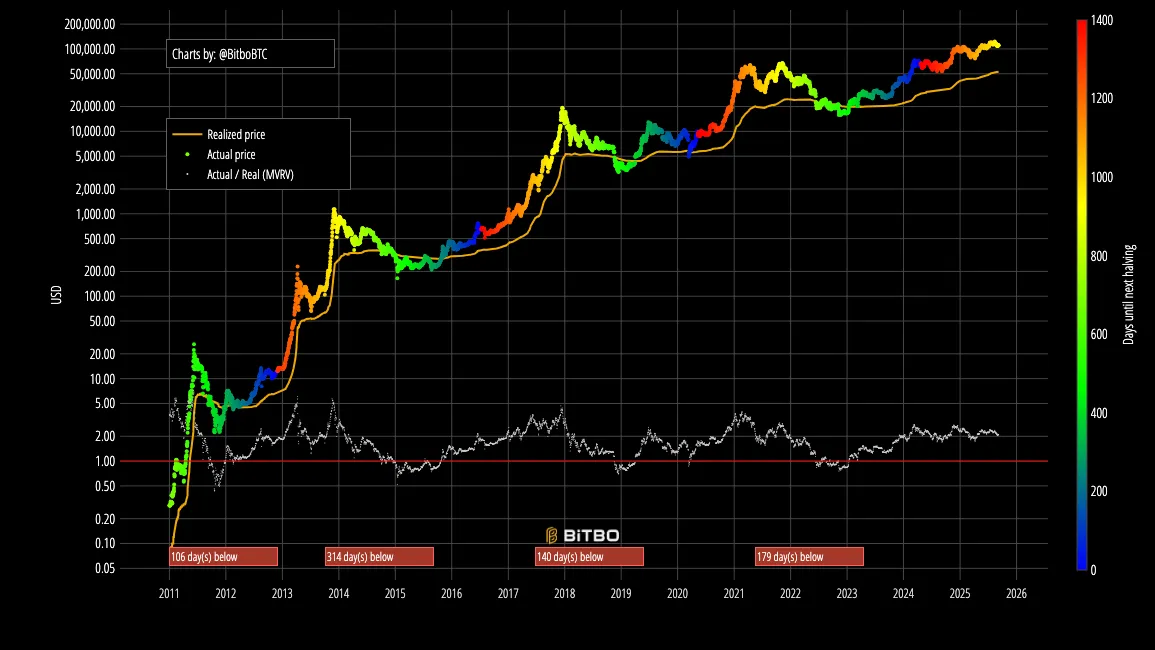What Are Realised Price Bands?
Realised Price bands are Bitcoin’s on-chain cost-basis ladders.
- Market Realised Price is the network’s average cost basis… Realised Cap ÷ circulating supply.
- LTH Realised Price is the average cost basis of coins held 155 days or more.
- STH Realised Price is the average cost basis of coins held less than 155 days.
These three levels give you a clean framework for where recent buyers sit, where patient holders sit, and where the market as a whole sits.

This chart shows Bitcoin’s spot price versus Realised Price across cycles, with MVRV beneath, to illustrate premium over cost basis.
How Are These Bands Calculated?
- Realised Cap: each coin is valued at the price it last moved on-chain, then summed.
- Market Realised Price: Realised Cap ÷ circulating supply.
- LTH / STH bands: the same calculation but limited to coins older than 155 days (LTH) or younger than 155 days (STH), divided by their respective cohort supply.
The 155-day cut-off is a convention that separates coins likely to belong to patient holders from coins owned by recent entrants.
Why These Bands Matter
- Behaviour map: STH RP tracks the pain/comfort of recent buyers; LTH RP tracks seasoned holders.
- Dynamic support/resistance: advances often retest STH RP from above; deeper resets can tag Market RP; prolonged stress can probe below it.
- Slope tells: rising LTH RP signals older capital upgrading cost basis via accumulation; a flat or falling LTH RP is less supportive.
Practical Reads

- STH RP reclaim and hold: a strong tell that pullbacks are being absorbed by newer buyers.
- Price above STH RP but below LTH RP: constructive, but not all cohorts are engaged yet.
- Distance from STH RP: the further price stretches above STH RP, the higher the risk of mean-reversion to it.
- Touches of Market RP: often align with value zones inside uptrends; repeated failures below it warn of broader weakness.
- Rising LTH RP during chop: quiet accumulation by stronger hands… improves the base.
Use With Confluence
Pair the bands with:
- SOPR / aSOPR: does the market absorb profit-taking near STH RP or reject it?
- Realised Profit/Loss: confirm whether gains are being distributed or held.
- MVRV / Z-Score: check if valuation premium is calm or stretched.
- Dormancy / CDD: see if older coins are actually moving when bands fail.
Common Pitfalls
- Treating any band as guaranteed support or resistance. They’re dynamic averages, not hard levels.
- Ignoring slope. A rising band beneath price is different from a flat or falling one.
- Reading bands in isolation without behaviour and valuation context.
A Simple Workflow You Can Reuse

- Open a weekly view with Market, LTH, and STH Realised Price.
- Note where price sits relative to STH, LTH, and Market RP.
- Check the slope of each band; rising or flattening?
- Cross-check aSOPR around 1.0 for absorption vs distribution.
- Add MVRV / Z-Score for valuation context.
- Decide: absorption with rising bands… or distribution risk with fading support.
FAQ
Why 155 days for LTH/STH?
It’s an empirically useful split: coins held ~5 months or more behave differently from recently moved coins.
What if price slices through STH RP?
That raises the chance of testing Market RP. Look for aSOPR < 1 and rising realised losses to confirm stress.
Can LTH RP fall?
Yes. If older coins move at lower prices, LTH RP can slip. Sustained rises usually require accumulation at higher prices.
If this helped you use cost basis the right way, join Alpha Insider for band interactions, pivot rules, and weekly timing windows. Fewer mistakes, cleaner execution, more conviction.
The Markets Unplugged members get:
➡️ Kairos timing windows to plan entries before the crowd moves
➡️ A full DCA Targets page with levels mapped for this cycle
➡️ Exclusive member videos breaking down charts in plain English
➡️ A private Telegram community where conviction is shared daily
➡️ A dedicated Bitcoin On-Chain Analysis page with regularly updated analysis and monthly reports (MVRV, SOPR, NUPL, Puell, URPD)
It’s the full playbook.















Discussion